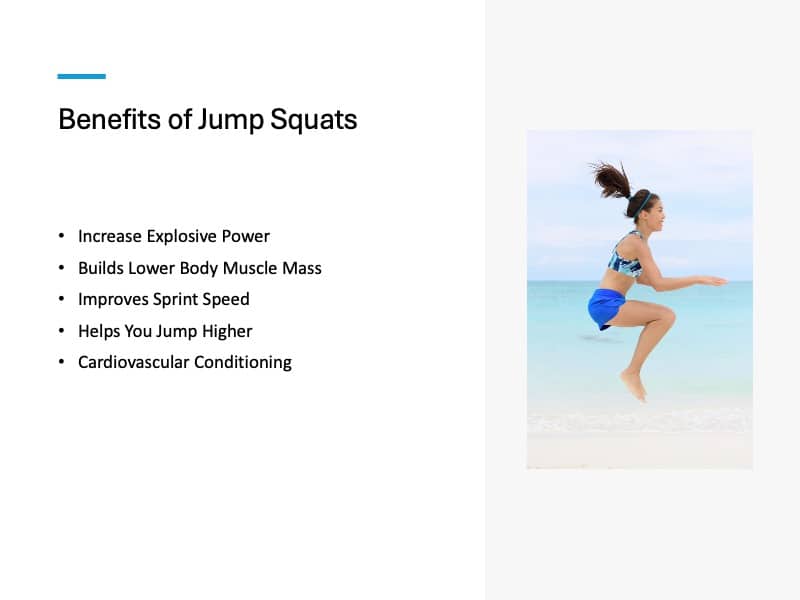Jump Squats: Benefits, How to Do, Muscles Worked & Pro Tips
Jump squats are a powerful exercise that combines the benefits of squats and plyometric exercises, resulting in improved strength, cardiovascular fitness, and athletic performance.
Many people think that jump squats are only necessary for people training for sports.
However, that is definitely not true.
As a professional basketball player, I’ve incorporated jump squats into my training for years, but their benefits extend well beyond sports-specific goals.
If you want to learn more about the mechanics, best variations, and benefits of jump squats, keep reading.
You’ll also find tips for integrating this powerful exercise into your routine. To see some of my favorite jump squat variations, check out my video below:
Keep reading below to learn a few specific benefits of jump squats and how to use jump squats in your workout routine!
What Muscles Do Jump Squats Work?
Jump squats are a highly effective, multi-joint exercise targeting several muscle groups, primarily in the lower body:
- Quadriceps: These muscles on the front of your thighs are responsible for extending your knees during the explosive upward jump.
- Hamstrings: Located at the back of your thighs, these muscles control the downward phase of the movement.
- Glutes: The largest muscles in your buttocks drive hip extension, crucial for power generation.
In addition to these primary muscles, jump squats engage:
- Core Muscles: Including the rectus abdominis, obliques, and lower back, which stabilize the spine and maintain proper form.
- Upper Body Muscles: Such as the deltoids and trapezius, which contribute to arm movement and overall balance.
This comprehensive muscle engagement makes jump squats a full-body exercise that enhances both strength and coordination.
Benefits of Jump Squats – What Do Jump Squats Do?

Jump squats deliver a range of benefits that go beyond basic strength training. Here’s a deeper look at why they deserve a spot in your fitness routine:
Increase Explosive Power
Jump squats are an incredibly effective exercise for building explosive power in the legs, making them a valuable addition to any workout routine.
While powerful legs are particularly beneficial for athletes, they also benefit anyone committed to exercising regularly.
In fact, the development of explosive power through jump squats can translate to other exercises, such as the back squat or deadlift, allowing individuals to lift more weight and achieve new personal records.
Additionally, adding jump squats to your routine can help break through weight-lifting plateaus.
When you perform the same exercises over and over again, your muscles can adapt and become accustomed to the workload, making it more difficult to continue making progress.
By regularly challenging your muscles with this explosive exercise, you’ll not only build power but also improve overall muscle responsiveness and efficiency.
This benefit extends beyond athletic performance to daily activities, such as climbing stairs or lifting heavy objects, where explosive strength plays a crucial role.
Builds Lower Body Muscle Mass
Though not traditionally considered a hypertrophy exercise, jump squats stimulate lower body muscle growth by forcing muscles to work at maximum capacity.
The intense nature of jump squats recruits fast-twitch muscle fibers, which are critical for both explosive power and muscle size.
For optimal results:
- Perform high-rep jump squats for endurance and hypertrophy.
- Use light weights to emphasize eccentric loading for muscle-building benefits.
Studies show weighted jump squats can enhance muscle architecture and improve braking ability, a key factor in athletic performance.
Also, research suggests that when performing jump squats, the difference in force between the legs will be negligible, even if you have imbalances in your lower body.
Weighted variations create greater tension in the muscles, particularly during the eccentric (lowering) phase, which is vital for muscle growth.
Additionally, the controlled landing in jump squats helps strengthen stabilizing muscles around the knees and hips, reducing the risk of injury and improving functional strength for other exercises and activities.
Improves Sprint Speed
Sprinting is a highly specific activity that requires a combination of power, speed, and agility.
If you want to improve your sprinting speed, incorporating jump squats into your workout routine may be a game-changer.
Research has shown that maximal concentric jump power is closely related to sprint acceleration, which means that building explosive power in the legs through jump squats can translate to improved sprinting speed.
In fact, a study published in the European Journal of Applied Physiology found that concentric force development is critical to sprint start performance, further emphasizing the importance of explosive power in the legs.
Another study published in Human Movement found that the height and power produced during the squat jump is the best predictor of sprinting speed.
Incorporating jump squats into your workout routine can help build explosive power in the legs, leading to improved sprinting speed and performance.
Helps You Jump Higher
Jump squats directly improve vertical jump height by training the fast-twitch muscle fibers responsible for explosive movement.
Whether for sports or personal goals, this exercise enhances your ability to generate upward force efficiently.
- By consistently practicing jump squats, you’ll not only strengthen the muscles required for jumping but also improve your neuromuscular coordination.
- This coordination is essential for transferring power from your lower body to your upper body, allowing for a more synchronized and effective jump.
Athletes in sports like basketball, volleyball, and track and field particularly benefit from this enhancement, as it can give them a competitive edge.
If you want to increase your vertical jump, start doing more jump squats!
Cardiovascular Conditioning
Jump squats provide an excellent cardiovascular workout when incorporated into high-intensity training protocols.
Their explosive nature elevates heart rate rapidly, making them a fantastic addition to interval training or circuit-based workouts. For example:
- Tabata Jump Squats: Performing jump squats in a Tabata workout format (20 seconds of work followed by 10 seconds of rest for 4 minutes) delivers an intense cardio challenge that burns calories and builds endurance.
- Circuit Training: Including jump squats in a circuit with other exercises like push-ups, mountain climbers, and burpees creates a dynamic workout that targets multiple fitness components simultaneously.
This combination of strength and cardio benefits not only improves heart health but also enhances stamina and overall conditioning, making jump squats an efficient and effective addition to any fitness routine.
How to Do Jump Squats
To maximize the benefits of jump squats, follow these steps:
- Start Position: Stand with your feet shoulder-width apart.
- Lower Down: Squat by bending at the hips and knees while keeping your chest upright and core engaged.
- Explosive Jump: Push through your heels and jump as high as possible, extending your arms overhead.
- Soft Landing: Land gently, bending your knees to absorb the impact, and immediately transition into the next rep.
How Much Weight Should You Use?
Proper form and technique are crucial when performing jump squats to prevent injury and maximize the benefits of the exercise. One of the most important considerations is focusing on weight selection to optimize performance.
The Case for Light or Bodyweight Jump Squats
A lesser-known yet critical aspect of jump squats is keeping the weight light and emphasizing speed.
Research has shown that adding too much weight can reduce power output, negating the explosive benefits of the exercise.
A study published in Sports Biomechanics found that system power output and joint power at the knee and ankle joints were maximized at 0% of one-rep max (1-RM).
As weights increased, power output diminished significantly, leading researchers to conclude that power is best optimized with bodyweight or very light resistance.
Light weights or bodyweight-only jump squats allow you to focus on speed and explosiveness—the core elements of this exercise.
By moving quickly through the upward phase, you train your fast-twitch muscle fibers more effectively, which directly impacts athletic performance.
This approach also minimizes strain on your joints, making jump squats accessible to a broader range of fitness levels.
Weighted Jump Squats: A Strategic Addition
While heavy resistance isn’t recommended for jump squats, light weights can provide additional benefits when used strategically.
Weighted jump squats can:
- Enhance eccentric control during landing.
- Improve muscle endurance by increasing time under tension.
- Target stabilizing muscles for greater joint stability.
However, bodyweight jump squats remain one of the most effective and versatile exercises in any fitness routine.
They require no equipment, can be performed anywhere, and still deliver tremendous benefits for power, strength, and coordination.
For most individuals, focusing on bodyweight or very light weights ensures optimal results without compromising technique or safety.
Final Thoughts – Jump Squats Benefits
As you can see, there are many advantages of adding jump squats to your current workout program.
You can combine jump squats with other strength and power exercises such as the Jacob’s Ladder Exercise and prowler sled exercise for a more complete “explosive power” workout.
Whether you want to jump higher, run faster, build stronger legs, or add lean muscle mass to your legs to help get an aesthetic body, jump squats are an effective exercise for you!
FAQs
Can Anyone Do Jump Squats?
Jump squats are a high-impact exercise that may not be suitable for everyone.
If you have joint pain or mobility issues, speak with your healthcare provider before attempting jump squats.
Are Jump Squats Safe?
Jump squats can be safe when performed with proper form and technique.
However, if you experience any pain or discomfort, stop immediately and speak with a healthcare provider.
How Often Should You Do Jump Squats?
The frequency of jump squats will depend on your fitness level and goals.
However, it is recommended to perform jump squats 2-3 times per week as part of a well-rounded fitness routine.
Can Jump Squats Replace Traditional Squats?
Jump squats are a great addition to a fitness routine, but they should not replace traditional squats entirely.
Traditional squats can help to build strength and muscle mass, while jump squats focus more on power and explosiveness.
This website does not provide medical advice. This website site does contain affiliate links, and purchases may earn a commission.
Read my Medical Disclaimer, Review Disclaimer, and Publishing Policies for more details. Use of this site indicates acceptance of these terms.



